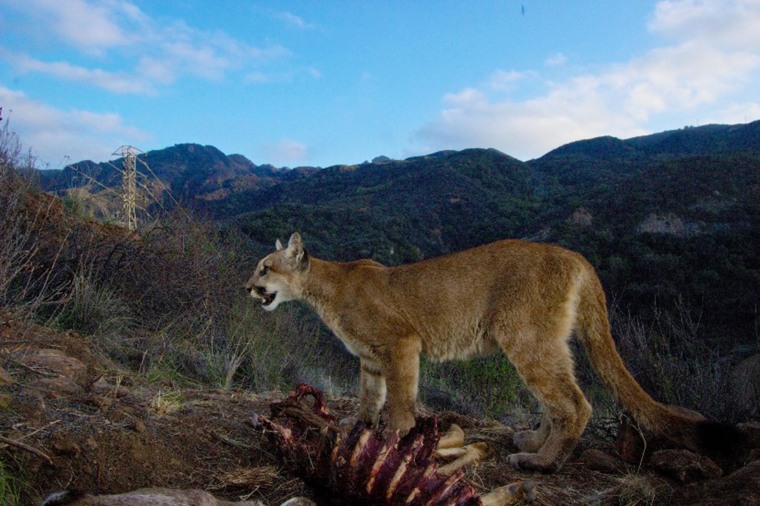Survival is anything but easy for the few dozen mountain lions living in the Santa Monica Mountains on the western edge of Los Angeles.
Hemmed in by a fence of highways and speeding vehicles, those trying to cross are likely to be killed — such was the fate of three kittens last January. And adult males defending territory have become so aggressive that they're killing offspring rather than cede ground. On top of all that, a new study found that the population is quickly losing its genetic diversity due to inbreeding.
The last, best hope for the big cats is getting a wildlife crossing built over U.S. 101 to connect their range to a much larger habitat area that includes the Los Padres National Forest, according to study lead author Seth Riley, a National Park Service ecologist.
"What we really need in the long run are the funds to build something," says Riley, whose team used radio collars to track 26 mountain lions, also known as cougars or pumas, over 10 years.
The study, reported last week in the peer-reviewed journal Current Biology, noted that 14 of those 26 didn't survive the decade. Six were killed by other cougars, two in attempted highway crossings and two from rat poison. One was illegally hunted, another starved and two deaths were from unknown causes.
The scientists also found that population's gene pool was quickly weakening until a lone male adult actually moved into the area and started mating.
For Riley's team, it was proof that the population could recover if given a chance.
"You don't need a lot from a genetic point of view," he says.
Bringing in new cougars isn't a long-term solution since the population would still be captive within the Santa Monica Mountains National Recreation Area. At 240 square miles, it is only big enough to sustain 10 mountain lions, the National Park Service reckons.

The idea of a wildlife crossing has been around for more than a decade, and backers initially focused on a $10 million tunnel at a spot along U.S. 101 near Liberty Canyon Road.
"We came within a whisper of getting $10 million about three years ago, but some Northern California project at the last second aced us out," recalls Paul Edelman, natural resources chief at the Mountains Recreation and Conservation Authority, a local governmental agency.
Backers are now focused on trying to get an overpass instead of a tunnel, arguing that while it would be more expensive it would also be much easier for wildlife to cross.
The conservation authority recently came up with $200,000 for a preliminary study on the overpass option. And Caltrans, the state's transportation department, is seeking $2 million in federal funding for more studies needed before any construction.
If it sounds complicated, that's because "this is a very unusual project," says Caltrans environmental planner Barbara Marquez.
Wildlife crossings can typically get quicker mitigation funding when part of new or expanded highway construction, but "this is a unique situation where the freeway was built a long time ago," says Marquez.
Riley is hopeful a crossing can be built within four years and figures the population can hold out at least that long before inbreeding causes reproductive failures.
That's also assuming the number of deaths doesn't spike. Besides the causes documented in the study, other concerns include wildfire and California's severe drought.
"Does drought significantly affect prey like rabbits and deer?" asks Riley. "We don't know."
For Riley, it's not a case of trying to save the last mountain lions — as a species, they'll continue in pockets across California and the country.
What's unique, he says, is "that there are still large carnivores in this megacity."
"That's what people love about the area — knowing that there are still wild places," he adds. "To lose the last ones is not an experiment we want to conduct."
